Strategic Management and Corporate Social Responsibility Analysis 2022
VerifiedAdded on 2022/10/18
|14
|3858
|15
AI Summary
Contribute Materials
Your contribution can guide someone’s learning journey. Share your
documents today.
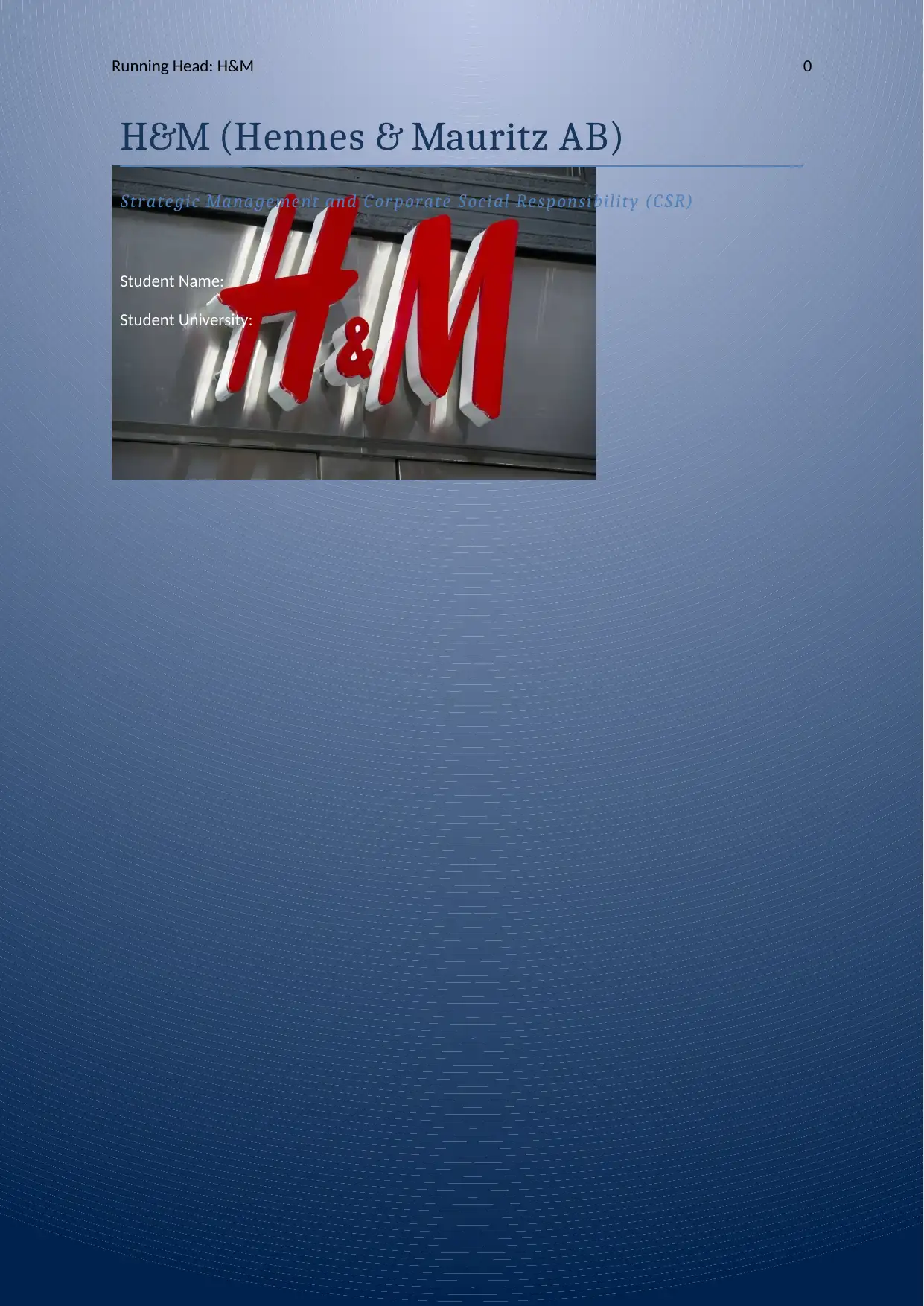
Running Head: H&M 0
H&M (Hennes & Mauritz AB)
Strategic Management and Corporate Social Responsibility (CSR)
Student Name:
Student University:
H&M (Hennes & Mauritz AB)
Strategic Management and Corporate Social Responsibility (CSR)
Student Name:
Student University:
Secure Best Marks with AI Grader
Need help grading? Try our AI Grader for instant feedback on your assignments.
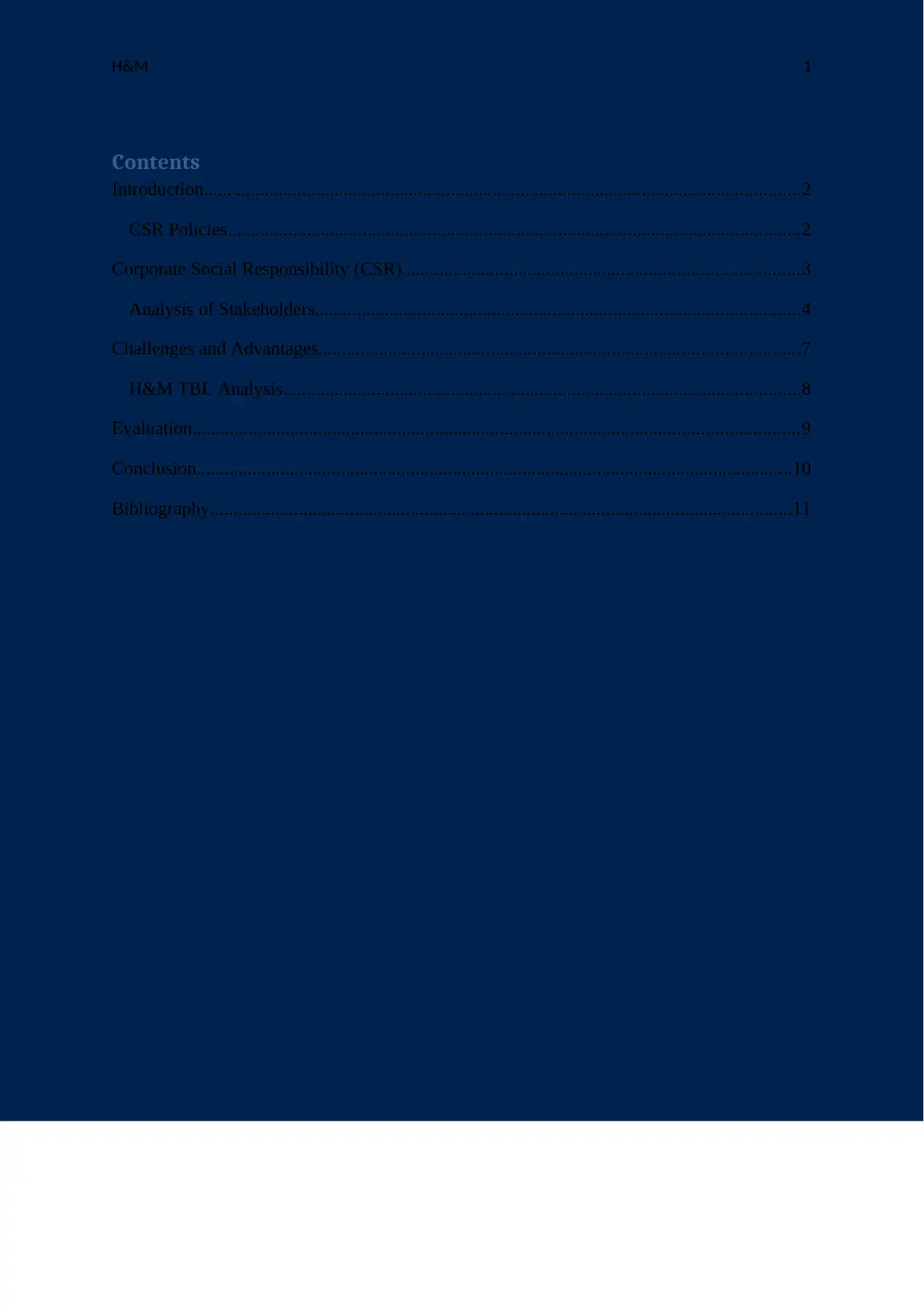
H&M 1
Contents
Introduction................................................................................................................................2
CSR Policies...........................................................................................................................2
Corporate Social Responsibility (CSR).....................................................................................3
Analysis of Stakeholders........................................................................................................4
Challenges and Advantages.......................................................................................................7
H&M TBL Analysis...............................................................................................................8
Evaluation..................................................................................................................................9
Conclusion................................................................................................................................10
Bibliography.............................................................................................................................11
Contents
Introduction................................................................................................................................2
CSR Policies...........................................................................................................................2
Corporate Social Responsibility (CSR).....................................................................................3
Analysis of Stakeholders........................................................................................................4
Challenges and Advantages.......................................................................................................7
H&M TBL Analysis...............................................................................................................8
Evaluation..................................................................................................................................9
Conclusion................................................................................................................................10
Bibliography.............................................................................................................................11
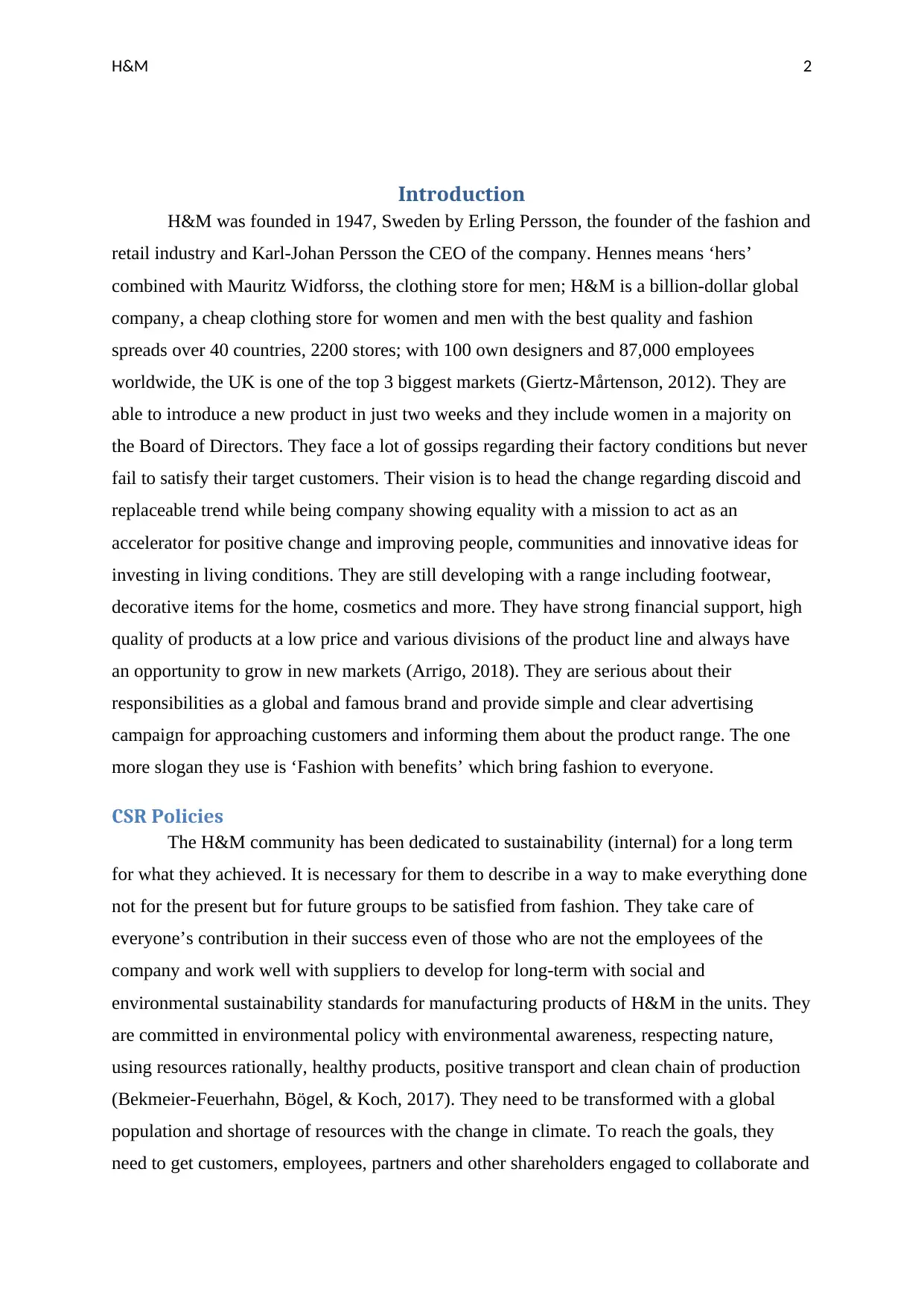
H&M 2
Introduction
H&M was founded in 1947, Sweden by Erling Persson, the founder of the fashion and
retail industry and Karl-Johan Persson the CEO of the company. Hennes means ‘hers’
combined with Mauritz Widforss, the clothing store for men; H&M is a billion-dollar global
company, a cheap clothing store for women and men with the best quality and fashion
spreads over 40 countries, 2200 stores; with 100 own designers and 87,000 employees
worldwide, the UK is one of the top 3 biggest markets (Giertz-Mårtenson, 2012). They are
able to introduce a new product in just two weeks and they include women in a majority on
the Board of Directors. They face a lot of gossips regarding their factory conditions but never
fail to satisfy their target customers. Their vision is to head the change regarding discoid and
replaceable trend while being company showing equality with a mission to act as an
accelerator for positive change and improving people, communities and innovative ideas for
investing in living conditions. They are still developing with a range including footwear,
decorative items for the home, cosmetics and more. They have strong financial support, high
quality of products at a low price and various divisions of the product line and always have
an opportunity to grow in new markets (Arrigo, 2018). They are serious about their
responsibilities as a global and famous brand and provide simple and clear advertising
campaign for approaching customers and informing them about the product range. The one
more slogan they use is ‘Fashion with benefits’ which bring fashion to everyone.
CSR Policies
The H&M community has been dedicated to sustainability (internal) for a long term
for what they achieved. It is necessary for them to describe in a way to make everything done
not for the present but for future groups to be satisfied from fashion. They take care of
everyone’s contribution in their success even of those who are not the employees of the
company and work well with suppliers to develop for long-term with social and
environmental sustainability standards for manufacturing products of H&M in the units. They
are committed in environmental policy with environmental awareness, respecting nature,
using resources rationally, healthy products, positive transport and clean chain of production
(Bekmeier-Feuerhahn, Bögel, & Koch, 2017). They need to be transformed with a global
population and shortage of resources with the change in climate. To reach the goals, they
need to get customers, employees, partners and other shareholders engaged to collaborate and
Introduction
H&M was founded in 1947, Sweden by Erling Persson, the founder of the fashion and
retail industry and Karl-Johan Persson the CEO of the company. Hennes means ‘hers’
combined with Mauritz Widforss, the clothing store for men; H&M is a billion-dollar global
company, a cheap clothing store for women and men with the best quality and fashion
spreads over 40 countries, 2200 stores; with 100 own designers and 87,000 employees
worldwide, the UK is one of the top 3 biggest markets (Giertz-Mårtenson, 2012). They are
able to introduce a new product in just two weeks and they include women in a majority on
the Board of Directors. They face a lot of gossips regarding their factory conditions but never
fail to satisfy their target customers. Their vision is to head the change regarding discoid and
replaceable trend while being company showing equality with a mission to act as an
accelerator for positive change and improving people, communities and innovative ideas for
investing in living conditions. They are still developing with a range including footwear,
decorative items for the home, cosmetics and more. They have strong financial support, high
quality of products at a low price and various divisions of the product line and always have
an opportunity to grow in new markets (Arrigo, 2018). They are serious about their
responsibilities as a global and famous brand and provide simple and clear advertising
campaign for approaching customers and informing them about the product range. The one
more slogan they use is ‘Fashion with benefits’ which bring fashion to everyone.
CSR Policies
The H&M community has been dedicated to sustainability (internal) for a long term
for what they achieved. It is necessary for them to describe in a way to make everything done
not for the present but for future groups to be satisfied from fashion. They take care of
everyone’s contribution in their success even of those who are not the employees of the
company and work well with suppliers to develop for long-term with social and
environmental sustainability standards for manufacturing products of H&M in the units. They
are committed in environmental policy with environmental awareness, respecting nature,
using resources rationally, healthy products, positive transport and clean chain of production
(Bekmeier-Feuerhahn, Bögel, & Koch, 2017). They need to be transformed with a global
population and shortage of resources with the change in climate. To reach the goals, they
need to get customers, employees, partners and other shareholders engaged to collaborate and
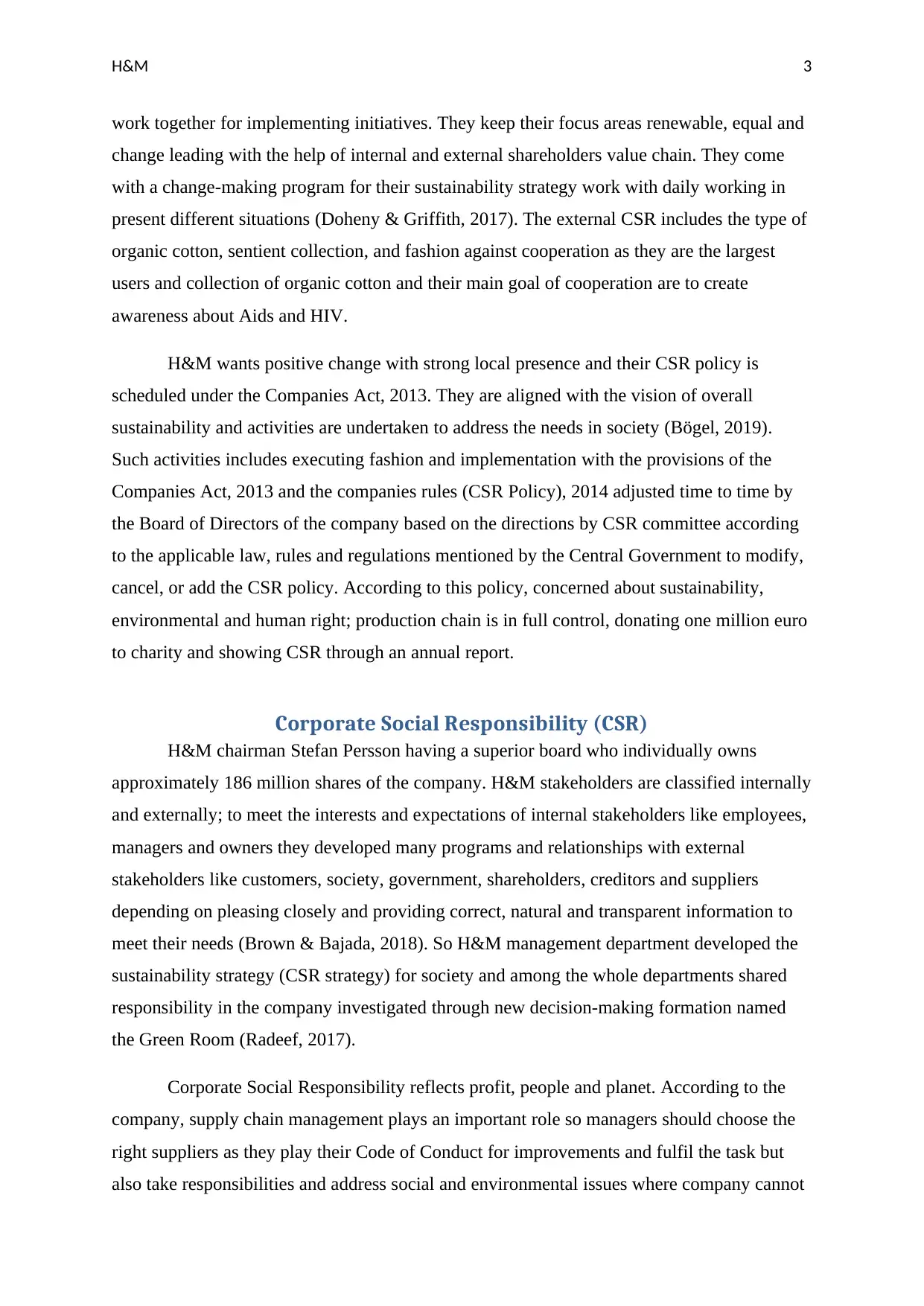
H&M 3
work together for implementing initiatives. They keep their focus areas renewable, equal and
change leading with the help of internal and external shareholders value chain. They come
with a change-making program for their sustainability strategy work with daily working in
present different situations (Doheny & Griffith, 2017). The external CSR includes the type of
organic cotton, sentient collection, and fashion against cooperation as they are the largest
users and collection of organic cotton and their main goal of cooperation are to create
awareness about Aids and HIV.
H&M wants positive change with strong local presence and their CSR policy is
scheduled under the Companies Act, 2013. They are aligned with the vision of overall
sustainability and activities are undertaken to address the needs in society (Bögel, 2019).
Such activities includes executing fashion and implementation with the provisions of the
Companies Act, 2013 and the companies rules (CSR Policy), 2014 adjusted time to time by
the Board of Directors of the company based on the directions by CSR committee according
to the applicable law, rules and regulations mentioned by the Central Government to modify,
cancel, or add the CSR policy. According to this policy, concerned about sustainability,
environmental and human right; production chain is in full control, donating one million euro
to charity and showing CSR through an annual report.
Corporate Social Responsibility (CSR)
H&M chairman Stefan Persson having a superior board who individually owns
approximately 186 million shares of the company. H&M stakeholders are classified internally
and externally; to meet the interests and expectations of internal stakeholders like employees,
managers and owners they developed many programs and relationships with external
stakeholders like customers, society, government, shareholders, creditors and suppliers
depending on pleasing closely and providing correct, natural and transparent information to
meet their needs (Brown & Bajada, 2018). So H&M management department developed the
sustainability strategy (CSR strategy) for society and among the whole departments shared
responsibility in the company investigated through new decision-making formation named
the Green Room (Radeef, 2017).
Corporate Social Responsibility reflects profit, people and planet. According to the
company, supply chain management plays an important role so managers should choose the
right suppliers as they play their Code of Conduct for improvements and fulfil the task but
also take responsibilities and address social and environmental issues where company cannot
work together for implementing initiatives. They keep their focus areas renewable, equal and
change leading with the help of internal and external shareholders value chain. They come
with a change-making program for their sustainability strategy work with daily working in
present different situations (Doheny & Griffith, 2017). The external CSR includes the type of
organic cotton, sentient collection, and fashion against cooperation as they are the largest
users and collection of organic cotton and their main goal of cooperation are to create
awareness about Aids and HIV.
H&M wants positive change with strong local presence and their CSR policy is
scheduled under the Companies Act, 2013. They are aligned with the vision of overall
sustainability and activities are undertaken to address the needs in society (Bögel, 2019).
Such activities includes executing fashion and implementation with the provisions of the
Companies Act, 2013 and the companies rules (CSR Policy), 2014 adjusted time to time by
the Board of Directors of the company based on the directions by CSR committee according
to the applicable law, rules and regulations mentioned by the Central Government to modify,
cancel, or add the CSR policy. According to this policy, concerned about sustainability,
environmental and human right; production chain is in full control, donating one million euro
to charity and showing CSR through an annual report.
Corporate Social Responsibility (CSR)
H&M chairman Stefan Persson having a superior board who individually owns
approximately 186 million shares of the company. H&M stakeholders are classified internally
and externally; to meet the interests and expectations of internal stakeholders like employees,
managers and owners they developed many programs and relationships with external
stakeholders like customers, society, government, shareholders, creditors and suppliers
depending on pleasing closely and providing correct, natural and transparent information to
meet their needs (Brown & Bajada, 2018). So H&M management department developed the
sustainability strategy (CSR strategy) for society and among the whole departments shared
responsibility in the company investigated through new decision-making formation named
the Green Room (Radeef, 2017).
Corporate Social Responsibility reflects profit, people and planet. According to the
company, supply chain management plays an important role so managers should choose the
right suppliers as they play their Code of Conduct for improvements and fulfil the task but
also take responsibilities and address social and environmental issues where company cannot
Secure Best Marks with AI Grader
Need help grading? Try our AI Grader for instant feedback on your assignments.
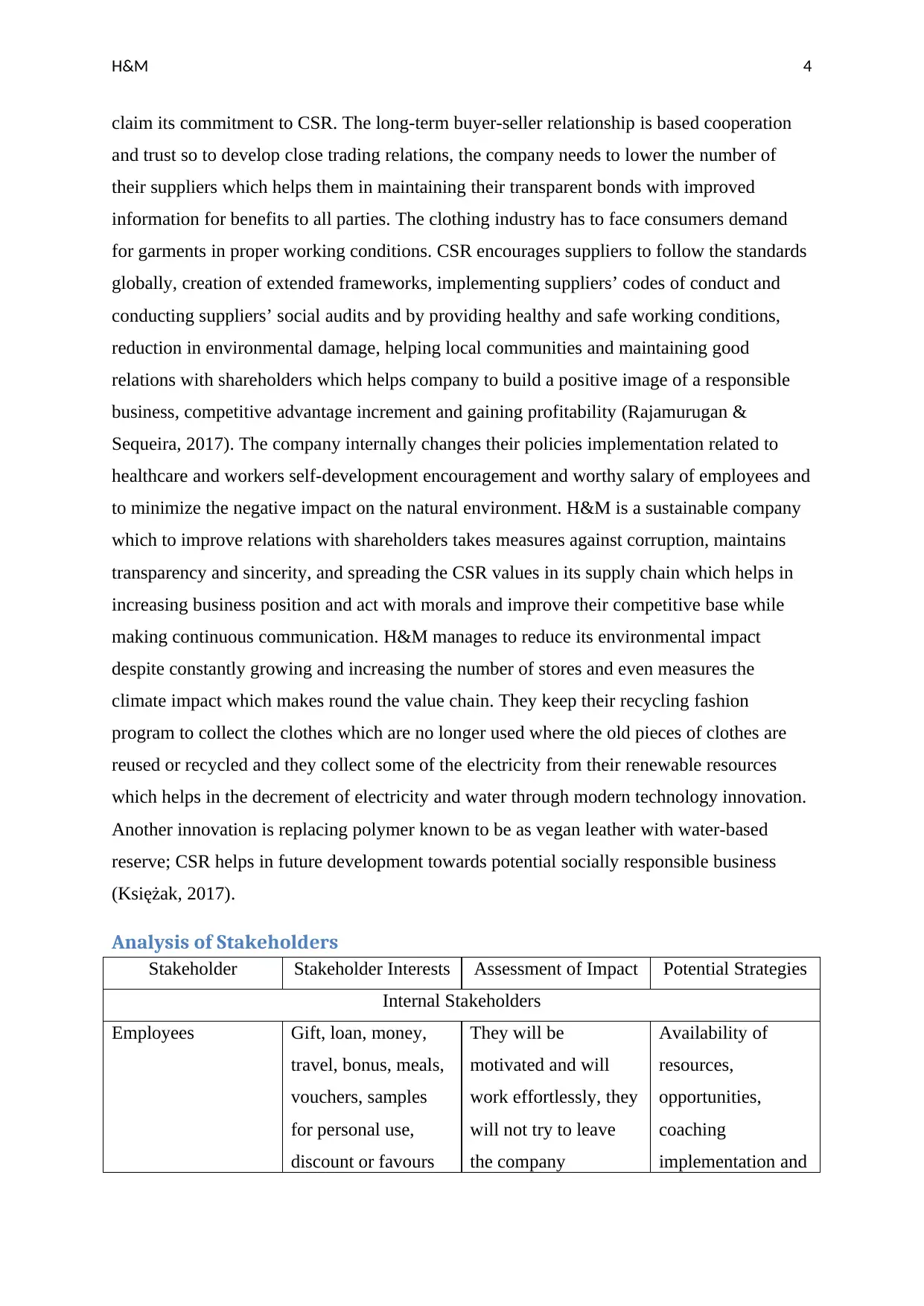
H&M 4
claim its commitment to CSR. The long-term buyer-seller relationship is based cooperation
and trust so to develop close trading relations, the company needs to lower the number of
their suppliers which helps them in maintaining their transparent bonds with improved
information for benefits to all parties. The clothing industry has to face consumers demand
for garments in proper working conditions. CSR encourages suppliers to follow the standards
globally, creation of extended frameworks, implementing suppliers’ codes of conduct and
conducting suppliers’ social audits and by providing healthy and safe working conditions,
reduction in environmental damage, helping local communities and maintaining good
relations with shareholders which helps company to build a positive image of a responsible
business, competitive advantage increment and gaining profitability (Rajamurugan &
Sequeira, 2017). The company internally changes their policies implementation related to
healthcare and workers self-development encouragement and worthy salary of employees and
to minimize the negative impact on the natural environment. H&M is a sustainable company
which to improve relations with shareholders takes measures against corruption, maintains
transparency and sincerity, and spreading the CSR values in its supply chain which helps in
increasing business position and act with morals and improve their competitive base while
making continuous communication. H&M manages to reduce its environmental impact
despite constantly growing and increasing the number of stores and even measures the
climate impact which makes round the value chain. They keep their recycling fashion
program to collect the clothes which are no longer used where the old pieces of clothes are
reused or recycled and they collect some of the electricity from their renewable resources
which helps in the decrement of electricity and water through modern technology innovation.
Another innovation is replacing polymer known to be as vegan leather with water-based
reserve; CSR helps in future development towards potential socially responsible business
(Księżak, 2017).
Analysis of Stakeholders
Stakeholder Stakeholder Interests Assessment of Impact Potential Strategies
Internal Stakeholders
Employees Gift, loan, money,
travel, bonus, meals,
vouchers, samples
for personal use,
discount or favours
They will be
motivated and will
work effortlessly, they
will not try to leave
the company
Availability of
resources,
opportunities,
coaching
implementation and
claim its commitment to CSR. The long-term buyer-seller relationship is based cooperation
and trust so to develop close trading relations, the company needs to lower the number of
their suppliers which helps them in maintaining their transparent bonds with improved
information for benefits to all parties. The clothing industry has to face consumers demand
for garments in proper working conditions. CSR encourages suppliers to follow the standards
globally, creation of extended frameworks, implementing suppliers’ codes of conduct and
conducting suppliers’ social audits and by providing healthy and safe working conditions,
reduction in environmental damage, helping local communities and maintaining good
relations with shareholders which helps company to build a positive image of a responsible
business, competitive advantage increment and gaining profitability (Rajamurugan &
Sequeira, 2017). The company internally changes their policies implementation related to
healthcare and workers self-development encouragement and worthy salary of employees and
to minimize the negative impact on the natural environment. H&M is a sustainable company
which to improve relations with shareholders takes measures against corruption, maintains
transparency and sincerity, and spreading the CSR values in its supply chain which helps in
increasing business position and act with morals and improve their competitive base while
making continuous communication. H&M manages to reduce its environmental impact
despite constantly growing and increasing the number of stores and even measures the
climate impact which makes round the value chain. They keep their recycling fashion
program to collect the clothes which are no longer used where the old pieces of clothes are
reused or recycled and they collect some of the electricity from their renewable resources
which helps in the decrement of electricity and water through modern technology innovation.
Another innovation is replacing polymer known to be as vegan leather with water-based
reserve; CSR helps in future development towards potential socially responsible business
(Księżak, 2017).
Analysis of Stakeholders
Stakeholder Stakeholder Interests Assessment of Impact Potential Strategies
Internal Stakeholders
Employees Gift, loan, money,
travel, bonus, meals,
vouchers, samples
for personal use,
discount or favours
They will be
motivated and will
work effortlessly, they
will not try to leave
the company
Availability of
resources,
opportunities,
coaching
implementation and
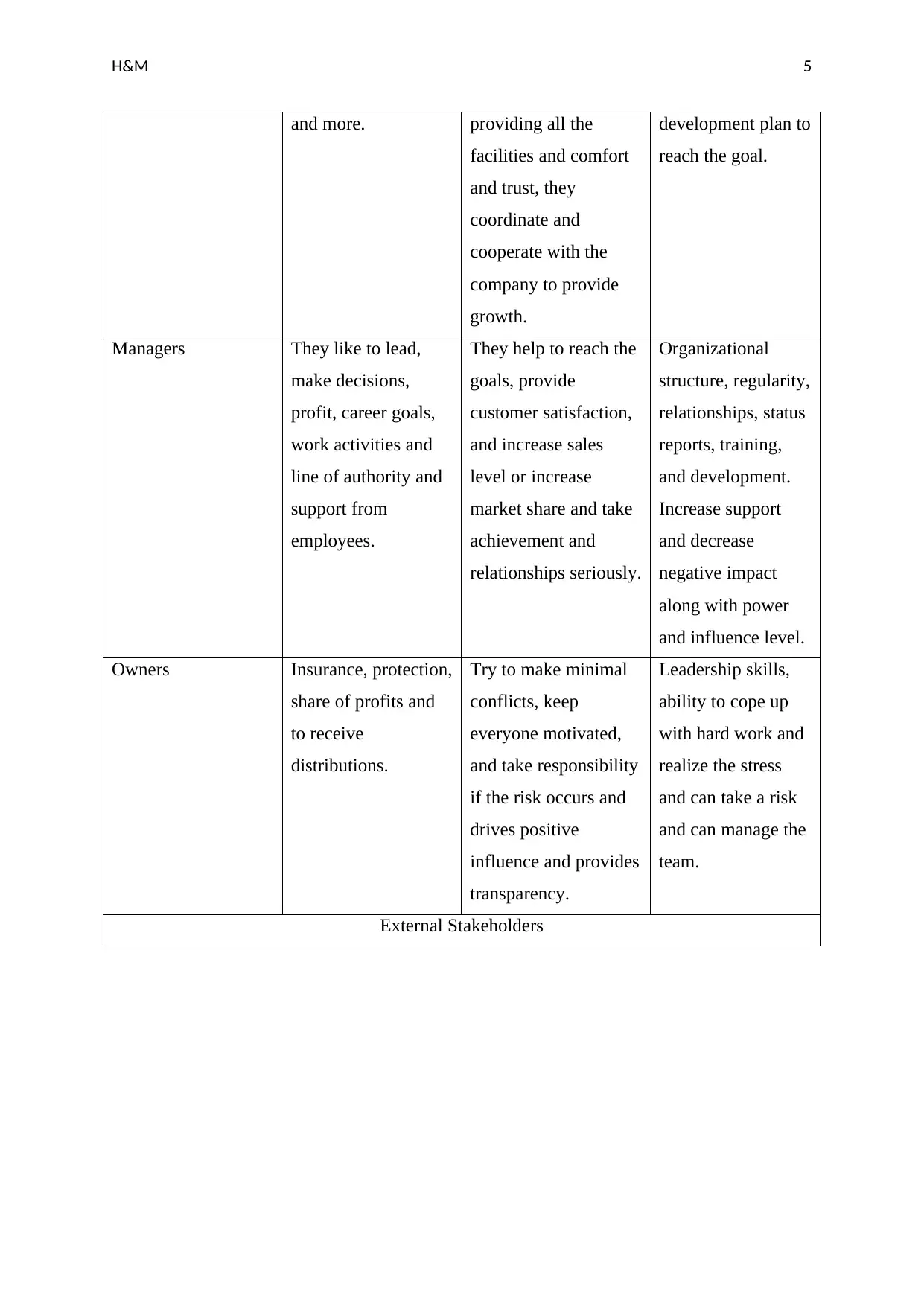
H&M 5
and more. providing all the
facilities and comfort
and trust, they
coordinate and
cooperate with the
company to provide
growth.
development plan to
reach the goal.
Managers They like to lead,
make decisions,
profit, career goals,
work activities and
line of authority and
support from
employees.
They help to reach the
goals, provide
customer satisfaction,
and increase sales
level or increase
market share and take
achievement and
relationships seriously.
Organizational
structure, regularity,
relationships, status
reports, training,
and development.
Increase support
and decrease
negative impact
along with power
and influence level.
Owners Insurance, protection,
share of profits and
to receive
distributions.
Try to make minimal
conflicts, keep
everyone motivated,
and take responsibility
if the risk occurs and
drives positive
influence and provides
transparency.
Leadership skills,
ability to cope up
with hard work and
realize the stress
and can take a risk
and can manage the
team.
External Stakeholders
and more. providing all the
facilities and comfort
and trust, they
coordinate and
cooperate with the
company to provide
growth.
development plan to
reach the goal.
Managers They like to lead,
make decisions,
profit, career goals,
work activities and
line of authority and
support from
employees.
They help to reach the
goals, provide
customer satisfaction,
and increase sales
level or increase
market share and take
achievement and
relationships seriously.
Organizational
structure, regularity,
relationships, status
reports, training,
and development.
Increase support
and decrease
negative impact
along with power
and influence level.
Owners Insurance, protection,
share of profits and
to receive
distributions.
Try to make minimal
conflicts, keep
everyone motivated,
and take responsibility
if the risk occurs and
drives positive
influence and provides
transparency.
Leadership skills,
ability to cope up
with hard work and
realize the stress
and can take a risk
and can manage the
team.
External Stakeholders
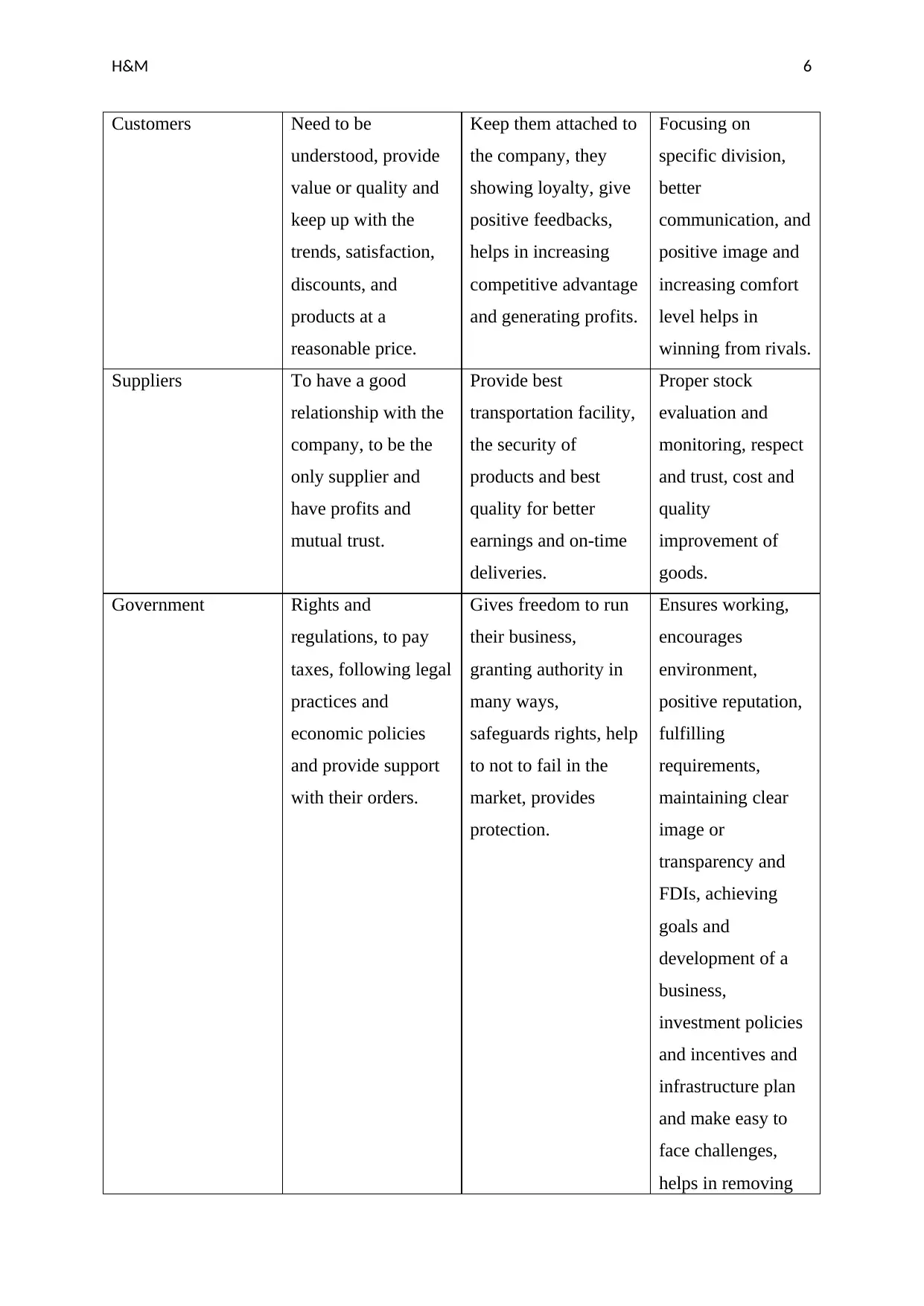
H&M 6
Customers Need to be
understood, provide
value or quality and
keep up with the
trends, satisfaction,
discounts, and
products at a
reasonable price.
Keep them attached to
the company, they
showing loyalty, give
positive feedbacks,
helps in increasing
competitive advantage
and generating profits.
Focusing on
specific division,
better
communication, and
positive image and
increasing comfort
level helps in
winning from rivals.
Suppliers To have a good
relationship with the
company, to be the
only supplier and
have profits and
mutual trust.
Provide best
transportation facility,
the security of
products and best
quality for better
earnings and on-time
deliveries.
Proper stock
evaluation and
monitoring, respect
and trust, cost and
quality
improvement of
goods.
Government Rights and
regulations, to pay
taxes, following legal
practices and
economic policies
and provide support
with their orders.
Gives freedom to run
their business,
granting authority in
many ways,
safeguards rights, help
to not to fail in the
market, provides
protection.
Ensures working,
encourages
environment,
positive reputation,
fulfilling
requirements,
maintaining clear
image or
transparency and
FDIs, achieving
goals and
development of a
business,
investment policies
and incentives and
infrastructure plan
and make easy to
face challenges,
helps in removing
Customers Need to be
understood, provide
value or quality and
keep up with the
trends, satisfaction,
discounts, and
products at a
reasonable price.
Keep them attached to
the company, they
showing loyalty, give
positive feedbacks,
helps in increasing
competitive advantage
and generating profits.
Focusing on
specific division,
better
communication, and
positive image and
increasing comfort
level helps in
winning from rivals.
Suppliers To have a good
relationship with the
company, to be the
only supplier and
have profits and
mutual trust.
Provide best
transportation facility,
the security of
products and best
quality for better
earnings and on-time
deliveries.
Proper stock
evaluation and
monitoring, respect
and trust, cost and
quality
improvement of
goods.
Government Rights and
regulations, to pay
taxes, following legal
practices and
economic policies
and provide support
with their orders.
Gives freedom to run
their business,
granting authority in
many ways,
safeguards rights, help
to not to fail in the
market, provides
protection.
Ensures working,
encourages
environment,
positive reputation,
fulfilling
requirements,
maintaining clear
image or
transparency and
FDIs, achieving
goals and
development of a
business,
investment policies
and incentives and
infrastructure plan
and make easy to
face challenges,
helps in removing
Paraphrase This Document
Need a fresh take? Get an instant paraphrase of this document with our AI Paraphraser
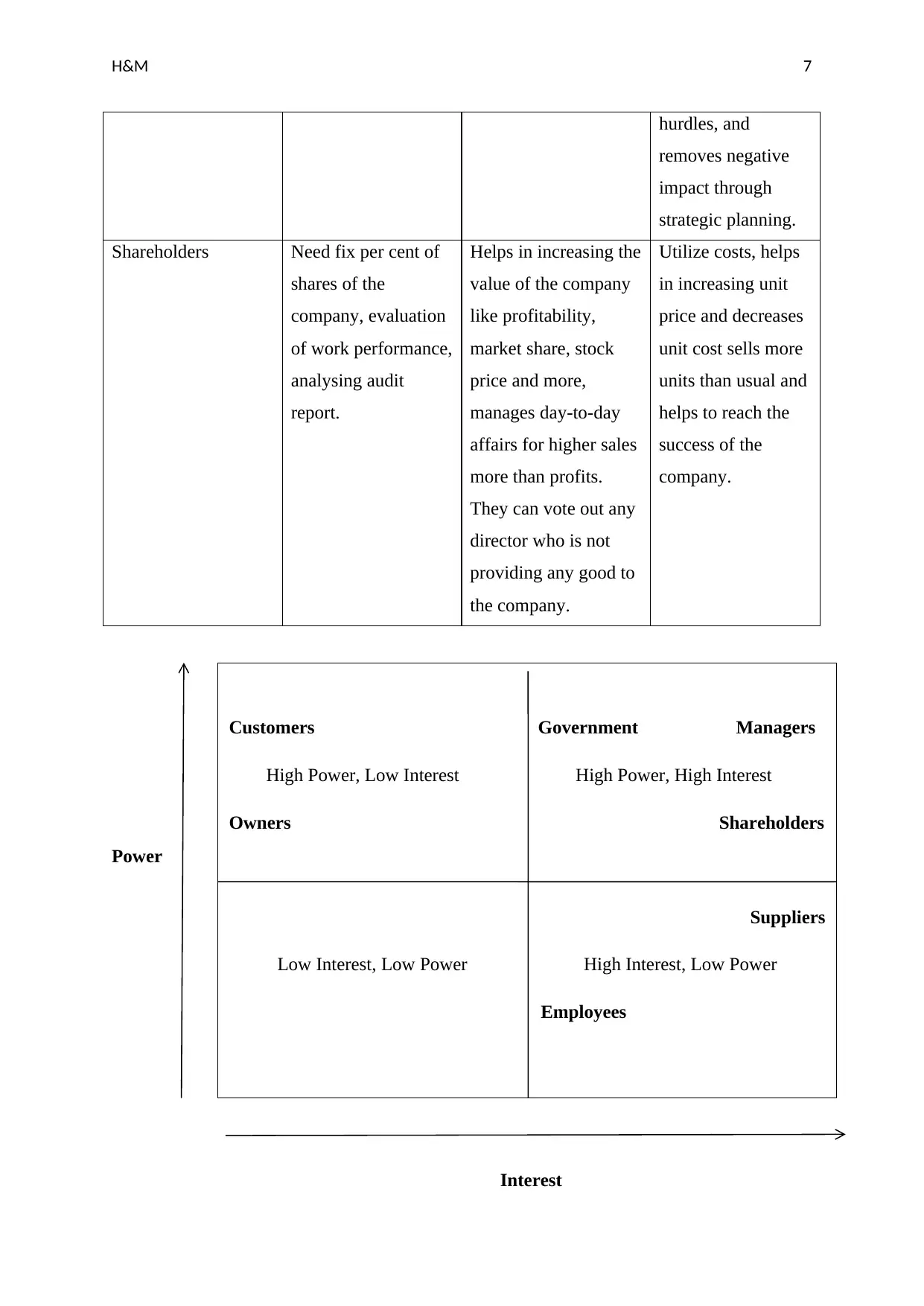
H&M 7
hurdles, and
removes negative
impact through
strategic planning.
Shareholders Need fix per cent of
shares of the
company, evaluation
of work performance,
analysing audit
report.
Helps in increasing the
value of the company
like profitability,
market share, stock
price and more,
manages day-to-day
affairs for higher sales
more than profits.
They can vote out any
director who is not
providing any good to
the company.
Utilize costs, helps
in increasing unit
price and decreases
unit cost sells more
units than usual and
helps to reach the
success of the
company.
Power
Interest
Customers Government Managers
High Power, Low Interest High Power, High Interest
Owners Shareholders
Suppliers
Low Interest, Low Power High Interest, Low Power
Employees
hurdles, and
removes negative
impact through
strategic planning.
Shareholders Need fix per cent of
shares of the
company, evaluation
of work performance,
analysing audit
report.
Helps in increasing the
value of the company
like profitability,
market share, stock
price and more,
manages day-to-day
affairs for higher sales
more than profits.
They can vote out any
director who is not
providing any good to
the company.
Utilize costs, helps
in increasing unit
price and decreases
unit cost sells more
units than usual and
helps to reach the
success of the
company.
Power
Interest
Customers Government Managers
High Power, Low Interest High Power, High Interest
Owners Shareholders
Suppliers
Low Interest, Low Power High Interest, Low Power
Employees
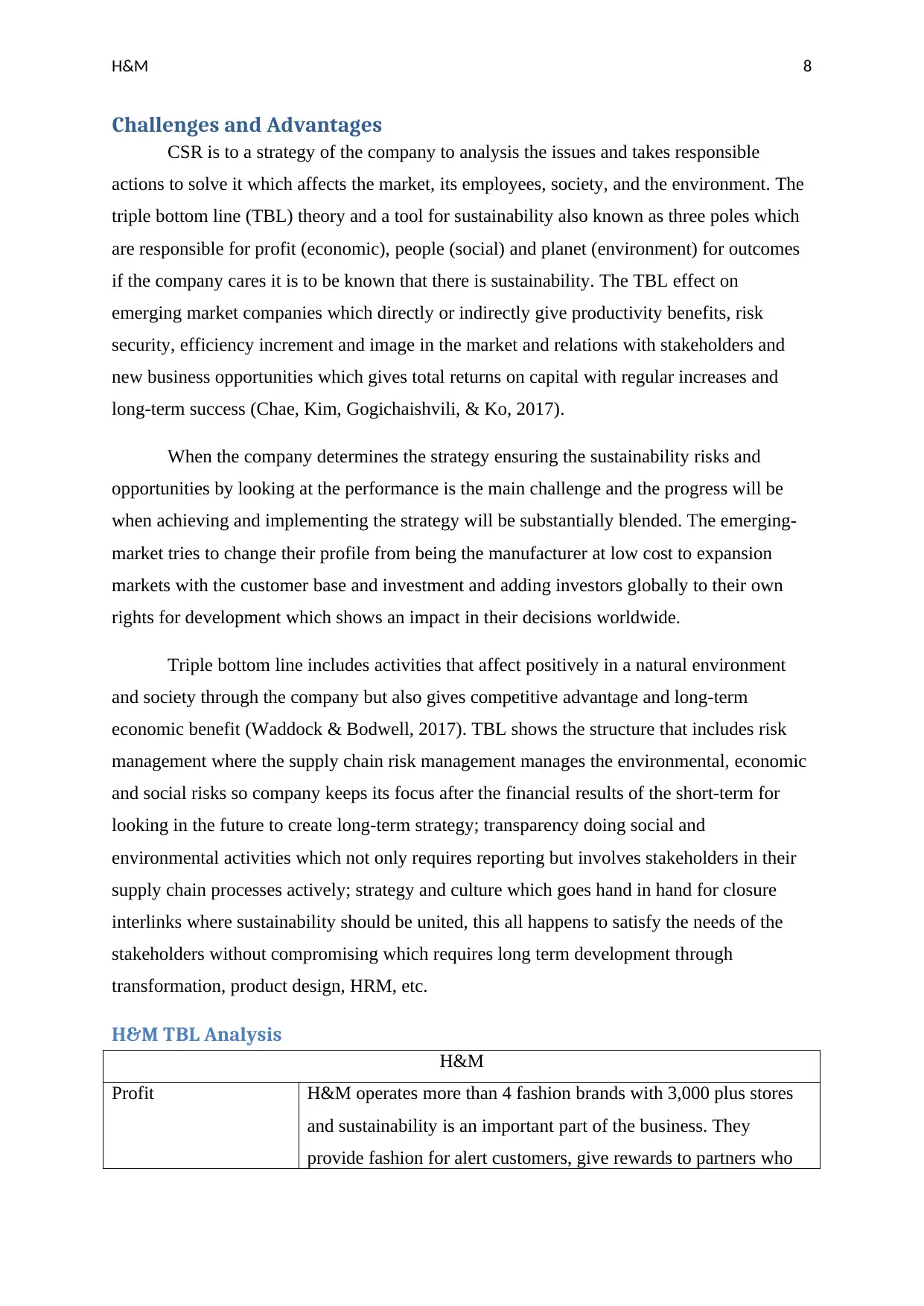
H&M 8
Challenges and Advantages
CSR is to a strategy of the company to analysis the issues and takes responsible
actions to solve it which affects the market, its employees, society, and the environment. The
triple bottom line (TBL) theory and a tool for sustainability also known as three poles which
are responsible for profit (economic), people (social) and planet (environment) for outcomes
if the company cares it is to be known that there is sustainability. The TBL effect on
emerging market companies which directly or indirectly give productivity benefits, risk
security, efficiency increment and image in the market and relations with stakeholders and
new business opportunities which gives total returns on capital with regular increases and
long-term success (Chae, Kim, Gogichaishvili, & Ko, 2017).
When the company determines the strategy ensuring the sustainability risks and
opportunities by looking at the performance is the main challenge and the progress will be
when achieving and implementing the strategy will be substantially blended. The emerging-
market tries to change their profile from being the manufacturer at low cost to expansion
markets with the customer base and investment and adding investors globally to their own
rights for development which shows an impact in their decisions worldwide.
Triple bottom line includes activities that affect positively in a natural environment
and society through the company but also gives competitive advantage and long-term
economic benefit (Waddock & Bodwell, 2017). TBL shows the structure that includes risk
management where the supply chain risk management manages the environmental, economic
and social risks so company keeps its focus after the financial results of the short-term for
looking in the future to create long-term strategy; transparency doing social and
environmental activities which not only requires reporting but involves stakeholders in their
supply chain processes actively; strategy and culture which goes hand in hand for closure
interlinks where sustainability should be united, this all happens to satisfy the needs of the
stakeholders without compromising which requires long term development through
transformation, product design, HRM, etc.
H&M TBL Analysis
H&M
Profit H&M operates more than 4 fashion brands with 3,000 plus stores
and sustainability is an important part of the business. They
provide fashion for alert customers, give rewards to partners who
Challenges and Advantages
CSR is to a strategy of the company to analysis the issues and takes responsible
actions to solve it which affects the market, its employees, society, and the environment. The
triple bottom line (TBL) theory and a tool for sustainability also known as three poles which
are responsible for profit (economic), people (social) and planet (environment) for outcomes
if the company cares it is to be known that there is sustainability. The TBL effect on
emerging market companies which directly or indirectly give productivity benefits, risk
security, efficiency increment and image in the market and relations with stakeholders and
new business opportunities which gives total returns on capital with regular increases and
long-term success (Chae, Kim, Gogichaishvili, & Ko, 2017).
When the company determines the strategy ensuring the sustainability risks and
opportunities by looking at the performance is the main challenge and the progress will be
when achieving and implementing the strategy will be substantially blended. The emerging-
market tries to change their profile from being the manufacturer at low cost to expansion
markets with the customer base and investment and adding investors globally to their own
rights for development which shows an impact in their decisions worldwide.
Triple bottom line includes activities that affect positively in a natural environment
and society through the company but also gives competitive advantage and long-term
economic benefit (Waddock & Bodwell, 2017). TBL shows the structure that includes risk
management where the supply chain risk management manages the environmental, economic
and social risks so company keeps its focus after the financial results of the short-term for
looking in the future to create long-term strategy; transparency doing social and
environmental activities which not only requires reporting but involves stakeholders in their
supply chain processes actively; strategy and culture which goes hand in hand for closure
interlinks where sustainability should be united, this all happens to satisfy the needs of the
stakeholders without compromising which requires long term development through
transformation, product design, HRM, etc.
H&M TBL Analysis
H&M
Profit H&M operates more than 4 fashion brands with 3,000 plus stores
and sustainability is an important part of the business. They
provide fashion for alert customers, give rewards to partners who
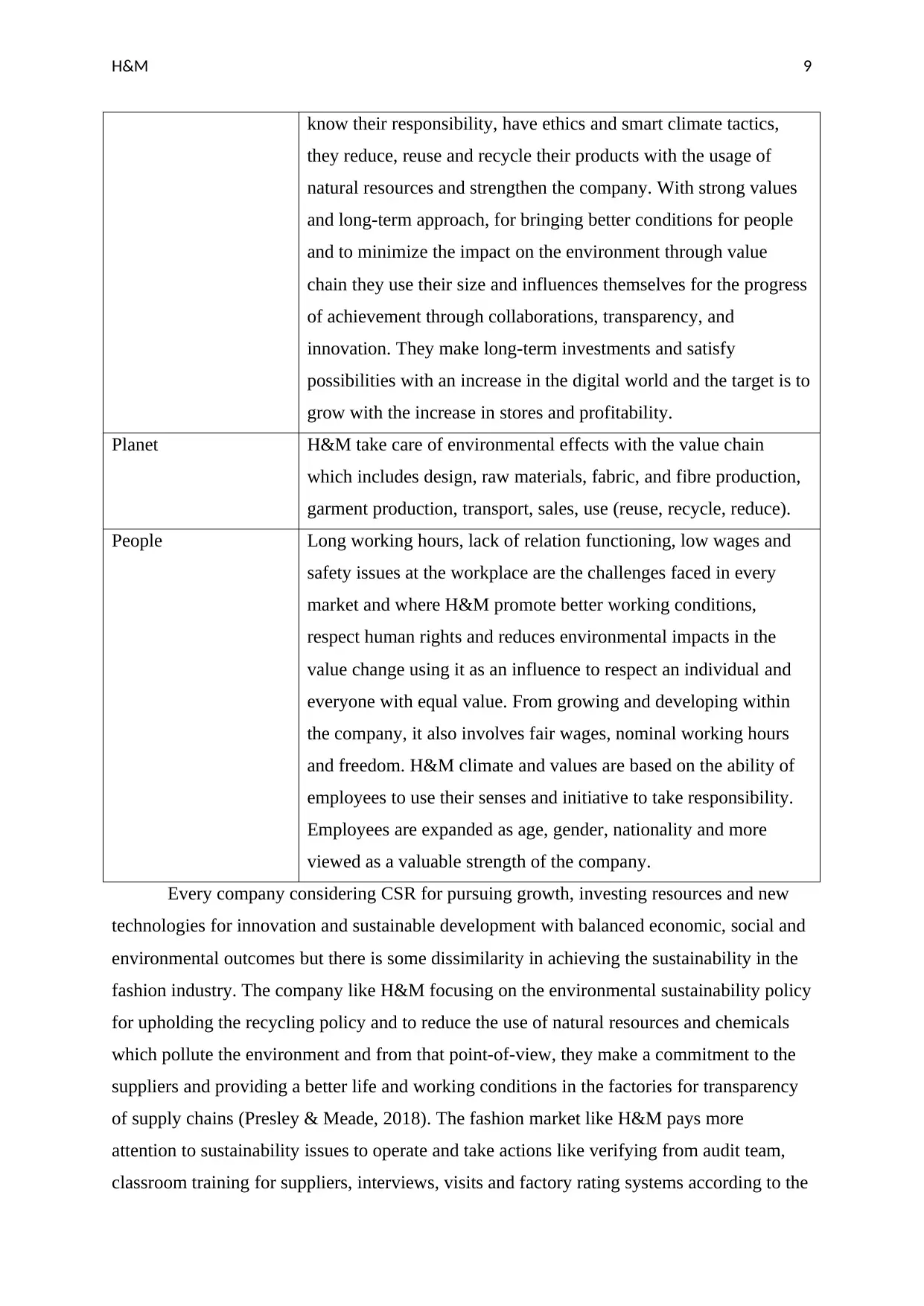
H&M 9
know their responsibility, have ethics and smart climate tactics,
they reduce, reuse and recycle their products with the usage of
natural resources and strengthen the company. With strong values
and long-term approach, for bringing better conditions for people
and to minimize the impact on the environment through value
chain they use their size and influences themselves for the progress
of achievement through collaborations, transparency, and
innovation. They make long-term investments and satisfy
possibilities with an increase in the digital world and the target is to
grow with the increase in stores and profitability.
Planet H&M take care of environmental effects with the value chain
which includes design, raw materials, fabric, and fibre production,
garment production, transport, sales, use (reuse, recycle, reduce).
People Long working hours, lack of relation functioning, low wages and
safety issues at the workplace are the challenges faced in every
market and where H&M promote better working conditions,
respect human rights and reduces environmental impacts in the
value change using it as an influence to respect an individual and
everyone with equal value. From growing and developing within
the company, it also involves fair wages, nominal working hours
and freedom. H&M climate and values are based on the ability of
employees to use their senses and initiative to take responsibility.
Employees are expanded as age, gender, nationality and more
viewed as a valuable strength of the company.
Every company considering CSR for pursuing growth, investing resources and new
technologies for innovation and sustainable development with balanced economic, social and
environmental outcomes but there is some dissimilarity in achieving the sustainability in the
fashion industry. The company like H&M focusing on the environmental sustainability policy
for upholding the recycling policy and to reduce the use of natural resources and chemicals
which pollute the environment and from that point-of-view, they make a commitment to the
suppliers and providing a better life and working conditions in the factories for transparency
of supply chains (Presley & Meade, 2018). The fashion market like H&M pays more
attention to sustainability issues to operate and take actions like verifying from audit team,
classroom training for suppliers, interviews, visits and factory rating systems according to the
know their responsibility, have ethics and smart climate tactics,
they reduce, reuse and recycle their products with the usage of
natural resources and strengthen the company. With strong values
and long-term approach, for bringing better conditions for people
and to minimize the impact on the environment through value
chain they use their size and influences themselves for the progress
of achievement through collaborations, transparency, and
innovation. They make long-term investments and satisfy
possibilities with an increase in the digital world and the target is to
grow with the increase in stores and profitability.
Planet H&M take care of environmental effects with the value chain
which includes design, raw materials, fabric, and fibre production,
garment production, transport, sales, use (reuse, recycle, reduce).
People Long working hours, lack of relation functioning, low wages and
safety issues at the workplace are the challenges faced in every
market and where H&M promote better working conditions,
respect human rights and reduces environmental impacts in the
value change using it as an influence to respect an individual and
everyone with equal value. From growing and developing within
the company, it also involves fair wages, nominal working hours
and freedom. H&M climate and values are based on the ability of
employees to use their senses and initiative to take responsibility.
Employees are expanded as age, gender, nationality and more
viewed as a valuable strength of the company.
Every company considering CSR for pursuing growth, investing resources and new
technologies for innovation and sustainable development with balanced economic, social and
environmental outcomes but there is some dissimilarity in achieving the sustainability in the
fashion industry. The company like H&M focusing on the environmental sustainability policy
for upholding the recycling policy and to reduce the use of natural resources and chemicals
which pollute the environment and from that point-of-view, they make a commitment to the
suppliers and providing a better life and working conditions in the factories for transparency
of supply chains (Presley & Meade, 2018). The fashion market like H&M pays more
attention to sustainability issues to operate and take actions like verifying from audit team,
classroom training for suppliers, interviews, visits and factory rating systems according to the
Secure Best Marks with AI Grader
Need help grading? Try our AI Grader for instant feedback on your assignments.
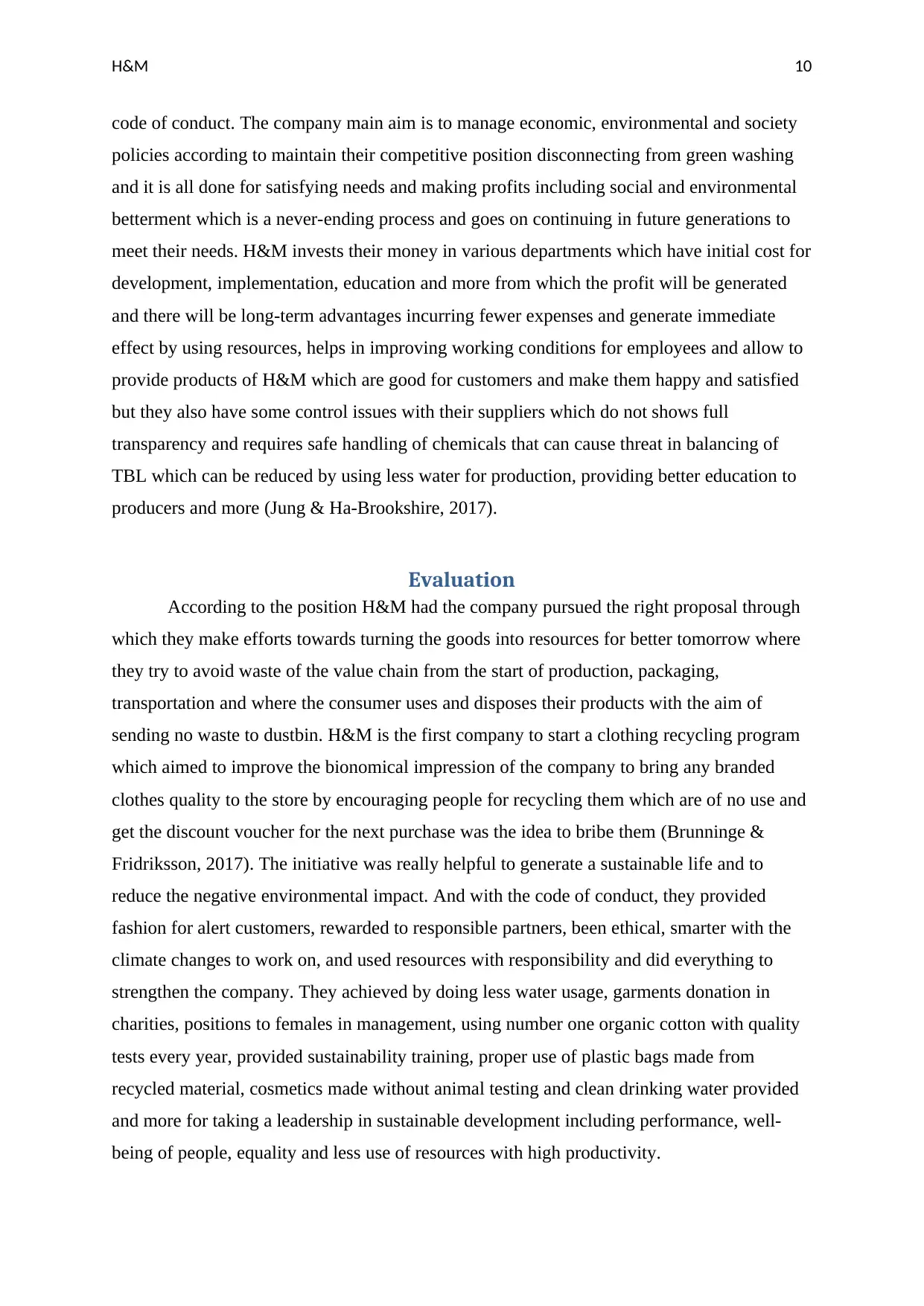
H&M 10
code of conduct. The company main aim is to manage economic, environmental and society
policies according to maintain their competitive position disconnecting from green washing
and it is all done for satisfying needs and making profits including social and environmental
betterment which is a never-ending process and goes on continuing in future generations to
meet their needs. H&M invests their money in various departments which have initial cost for
development, implementation, education and more from which the profit will be generated
and there will be long-term advantages incurring fewer expenses and generate immediate
effect by using resources, helps in improving working conditions for employees and allow to
provide products of H&M which are good for customers and make them happy and satisfied
but they also have some control issues with their suppliers which do not shows full
transparency and requires safe handling of chemicals that can cause threat in balancing of
TBL which can be reduced by using less water for production, providing better education to
producers and more (Jung & Ha‐Brookshire, 2017).
Evaluation
According to the position H&M had the company pursued the right proposal through
which they make efforts towards turning the goods into resources for better tomorrow where
they try to avoid waste of the value chain from the start of production, packaging,
transportation and where the consumer uses and disposes their products with the aim of
sending no waste to dustbin. H&M is the first company to start a clothing recycling program
which aimed to improve the bionomical impression of the company to bring any branded
clothes quality to the store by encouraging people for recycling them which are of no use and
get the discount voucher for the next purchase was the idea to bribe them (Brunninge &
Fridriksson, 2017). The initiative was really helpful to generate a sustainable life and to
reduce the negative environmental impact. And with the code of conduct, they provided
fashion for alert customers, rewarded to responsible partners, been ethical, smarter with the
climate changes to work on, and used resources with responsibility and did everything to
strengthen the company. They achieved by doing less water usage, garments donation in
charities, positions to females in management, using number one organic cotton with quality
tests every year, provided sustainability training, proper use of plastic bags made from
recycled material, cosmetics made without animal testing and clean drinking water provided
and more for taking a leadership in sustainable development including performance, well-
being of people, equality and less use of resources with high productivity.
code of conduct. The company main aim is to manage economic, environmental and society
policies according to maintain their competitive position disconnecting from green washing
and it is all done for satisfying needs and making profits including social and environmental
betterment which is a never-ending process and goes on continuing in future generations to
meet their needs. H&M invests their money in various departments which have initial cost for
development, implementation, education and more from which the profit will be generated
and there will be long-term advantages incurring fewer expenses and generate immediate
effect by using resources, helps in improving working conditions for employees and allow to
provide products of H&M which are good for customers and make them happy and satisfied
but they also have some control issues with their suppliers which do not shows full
transparency and requires safe handling of chemicals that can cause threat in balancing of
TBL which can be reduced by using less water for production, providing better education to
producers and more (Jung & Ha‐Brookshire, 2017).
Evaluation
According to the position H&M had the company pursued the right proposal through
which they make efforts towards turning the goods into resources for better tomorrow where
they try to avoid waste of the value chain from the start of production, packaging,
transportation and where the consumer uses and disposes their products with the aim of
sending no waste to dustbin. H&M is the first company to start a clothing recycling program
which aimed to improve the bionomical impression of the company to bring any branded
clothes quality to the store by encouraging people for recycling them which are of no use and
get the discount voucher for the next purchase was the idea to bribe them (Brunninge &
Fridriksson, 2017). The initiative was really helpful to generate a sustainable life and to
reduce the negative environmental impact. And with the code of conduct, they provided
fashion for alert customers, rewarded to responsible partners, been ethical, smarter with the
climate changes to work on, and used resources with responsibility and did everything to
strengthen the company. They achieved by doing less water usage, garments donation in
charities, positions to females in management, using number one organic cotton with quality
tests every year, provided sustainability training, proper use of plastic bags made from
recycled material, cosmetics made without animal testing and clean drinking water provided
and more for taking a leadership in sustainable development including performance, well-
being of people, equality and less use of resources with high productivity.
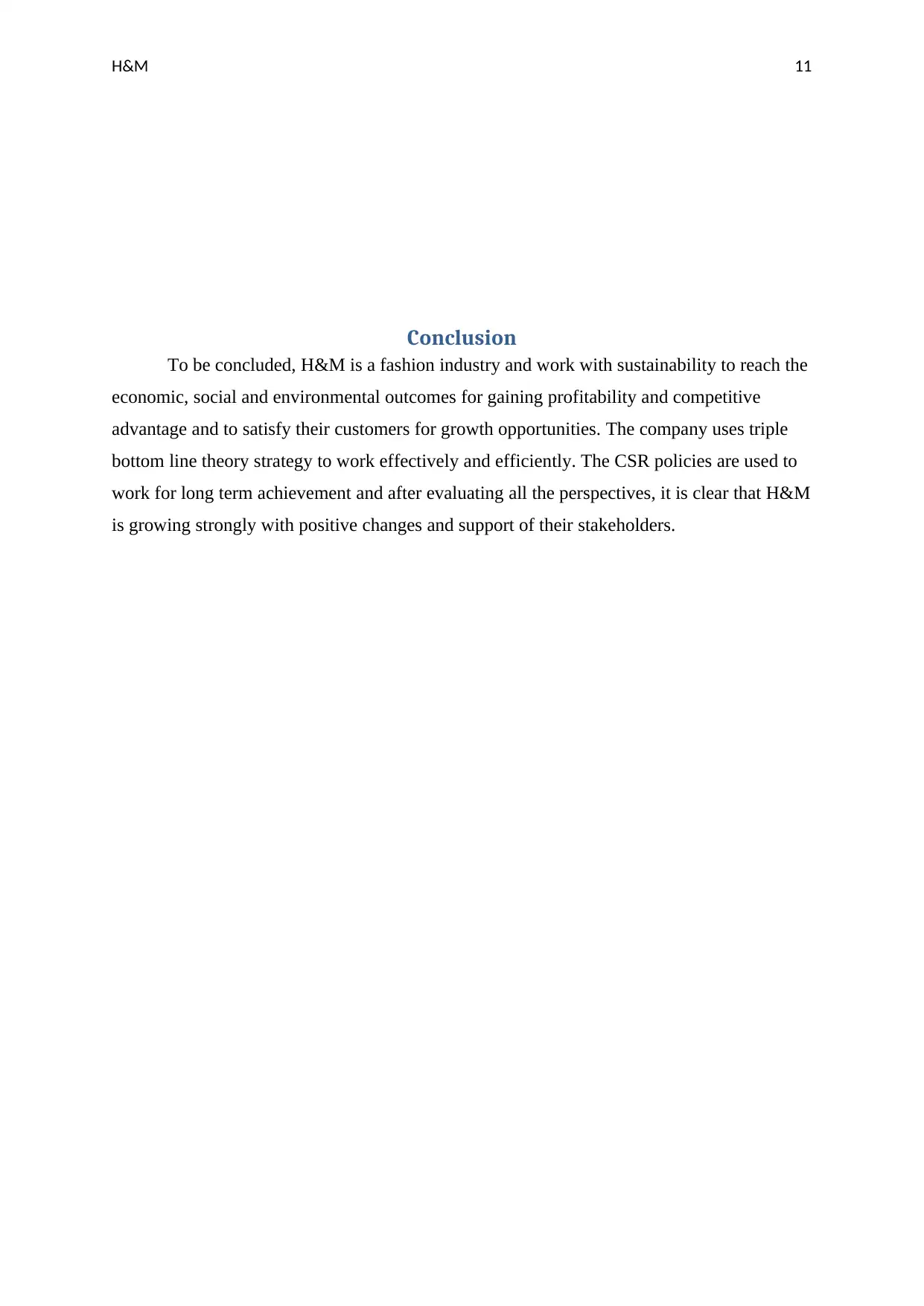
H&M 11
Conclusion
To be concluded, H&M is a fashion industry and work with sustainability to reach the
economic, social and environmental outcomes for gaining profitability and competitive
advantage and to satisfy their customers for growth opportunities. The company uses triple
bottom line theory strategy to work effectively and efficiently. The CSR policies are used to
work for long term achievement and after evaluating all the perspectives, it is clear that H&M
is growing strongly with positive changes and support of their stakeholders.
Conclusion
To be concluded, H&M is a fashion industry and work with sustainability to reach the
economic, social and environmental outcomes for gaining profitability and competitive
advantage and to satisfy their customers for growth opportunities. The company uses triple
bottom line theory strategy to work effectively and efficiently. The CSR policies are used to
work for long term achievement and after evaluating all the perspectives, it is clear that H&M
is growing strongly with positive changes and support of their stakeholders.

H&M 12
Bibliography
Arrigo, E. (2018). The key role of retail stores in fast fashion companies: The H&M case
study. In Contemporary Case Studies on Fashion Production, Marketing and
Operations. Singapore: Springer.
Bekmeier-Feuerhahn, S., Bögel, P. M., & Koch, C. (2017). Investigating internal CSR
communication: building a theoretical framework. In Handbook of Integrated CSR
Communication. Switzerland: Springer.
Bögel, P. M. (2019). Company reputation and its influence on consumer trust in response to
ongoing CSR communication. Journal of marketing communications, 25(2), 115-136.
Brown, P. J., & Bajada, C. (2018). An economic model of circular supply network dynamics:
Toward an understanding of performance measurement in the context of multiple
stakeholders. Business Strategy and the Environment, 27(5), 643-655.
Brunninge, O., & Fridriksson, H.-V. (2017). “We have always been responsible” A social
memory approach to responsibility in supply chains. European Business Review,
29(3), 372-383.
Chae, H., Kim, S., Gogichaishvili, T., & Ko, E. (2017). Influence of SPA Brands' Sustainable
Activities on the Consumer's Ethical Consciousness, Brand Loyalty and Purchase
Intention: Focused on H&M Brand (Korea vs. Russia). Fashion & Textile Research
Journal, 19(2), 207-220.
Doheny, M., & Griffith, J. A. (2017). CSR at Work: Considering Corporate Social
Responsibility from a Motivation to Act Perspective. Journal of Organizational
Psychology, 17(6), 126-141.
Bibliography
Arrigo, E. (2018). The key role of retail stores in fast fashion companies: The H&M case
study. In Contemporary Case Studies on Fashion Production, Marketing and
Operations. Singapore: Springer.
Bekmeier-Feuerhahn, S., Bögel, P. M., & Koch, C. (2017). Investigating internal CSR
communication: building a theoretical framework. In Handbook of Integrated CSR
Communication. Switzerland: Springer.
Bögel, P. M. (2019). Company reputation and its influence on consumer trust in response to
ongoing CSR communication. Journal of marketing communications, 25(2), 115-136.
Brown, P. J., & Bajada, C. (2018). An economic model of circular supply network dynamics:
Toward an understanding of performance measurement in the context of multiple
stakeholders. Business Strategy and the Environment, 27(5), 643-655.
Brunninge, O., & Fridriksson, H.-V. (2017). “We have always been responsible” A social
memory approach to responsibility in supply chains. European Business Review,
29(3), 372-383.
Chae, H., Kim, S., Gogichaishvili, T., & Ko, E. (2017). Influence of SPA Brands' Sustainable
Activities on the Consumer's Ethical Consciousness, Brand Loyalty and Purchase
Intention: Focused on H&M Brand (Korea vs. Russia). Fashion & Textile Research
Journal, 19(2), 207-220.
Doheny, M., & Griffith, J. A. (2017). CSR at Work: Considering Corporate Social
Responsibility from a Motivation to Act Perspective. Journal of Organizational
Psychology, 17(6), 126-141.
Paraphrase This Document
Need a fresh take? Get an instant paraphrase of this document with our AI Paraphraser

H&M 13
Giertz-Mårtenson, I. (2012). H&M–documenting the story of one of the world's largest
fashion retailers. Business history, 54(1), 108-115.
Jung, S., & Ha‐Brookshire, J. (2017). Perfect or imperfect duties? Developing a moral
responsibility framework for corporate sustainability from the consumer perspective.
Corporate Social Responsibility and Environmental Management, 24(4), 326-340.
Księżak, P. (2017). The CSR Challenges in the Clothing Industry. Journal of Corporate
Responsibility and Leadership, 3(2), 51-64.
Presley, A., & Meade, L. M. (2018). The business case for sustainability: An application to
slow fashion supply chains. IEEE Engineering Management Review, 46(2), 138-150.
Radeef, A. (2017). THE SECRET OF H&M GROUP SUCCESS IN THE LAST DECADE.
Rajamurugan , A., & Sequeira, A. H. (2017, July 20). A Study on Cause-Related Marketing:
Examining the Role of Hopes with CSR Approaches. Retrieved from SSRN:
https://papers.ssrn.com/sol3/papers.cfm?abstract_id=3005945
Waddock, S., & Bodwell, C. (2017). Total responsibility management: The manual. London:
Routledge.
Giertz-Mårtenson, I. (2012). H&M–documenting the story of one of the world's largest
fashion retailers. Business history, 54(1), 108-115.
Jung, S., & Ha‐Brookshire, J. (2017). Perfect or imperfect duties? Developing a moral
responsibility framework for corporate sustainability from the consumer perspective.
Corporate Social Responsibility and Environmental Management, 24(4), 326-340.
Księżak, P. (2017). The CSR Challenges in the Clothing Industry. Journal of Corporate
Responsibility and Leadership, 3(2), 51-64.
Presley, A., & Meade, L. M. (2018). The business case for sustainability: An application to
slow fashion supply chains. IEEE Engineering Management Review, 46(2), 138-150.
Radeef, A. (2017). THE SECRET OF H&M GROUP SUCCESS IN THE LAST DECADE.
Rajamurugan , A., & Sequeira, A. H. (2017, July 20). A Study on Cause-Related Marketing:
Examining the Role of Hopes with CSR Approaches. Retrieved from SSRN:
https://papers.ssrn.com/sol3/papers.cfm?abstract_id=3005945
Waddock, S., & Bodwell, C. (2017). Total responsibility management: The manual. London:
Routledge.
1 out of 14
Related Documents
Your All-in-One AI-Powered Toolkit for Academic Success.
+13062052269
info@desklib.com
Available 24*7 on WhatsApp / Email
![[object Object]](/_next/static/media/star-bottom.7253800d.svg)
Unlock your academic potential
© 2024 | Zucol Services PVT LTD | All rights reserved.




